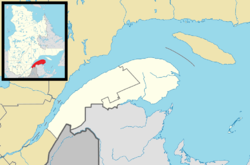Notre-Dame-des-Sept-Douleurs, Quebec
| Notre-Dame-des-Sept-Douleurs | |
|---|---|
| Parish municipality | |
 |
|
 Location within Rivière-du-Loup RCM |
|
| Location in eastern Quebec | |
| Coordinates: 48°00′N 69°27′W / 48.000°N 69.450°WCoordinates: 48°00′N 69°27′W / 48.000°N 69.450°W | |
| Country |
|
| Province |
|
| Region | Bas-Saint-Laurent |
| RCM | Rivière-du-Loup |
| Constituted | January 1, 1874 |
| Government | |
| • Mayor | Gilbert Delage |
| • Federal riding | Montmagny—L'Islet—Kamouraska—Rivière-du-Loup |
| • Prov. riding | Rivière-du-Loup-Témiscouata |
| Area | |
| • Total | 141.80 km2 (54.75 sq mi) |
| • Land | 11.61 km2 (4.48 sq mi) |
| Population (2011) | |
| • Total | 49 |
| • Density | 4.2/km2 (11/sq mi) |
| • Pop 2006-2011 |
|
| • Dwellings | 104 |
| Time zone | EST (UTC−5) |
| • Summer (DST) | EDT (UTC−4) |
| Postal code(s) | G0L 1K0 |
| Area code(s) | 418 and 581 |
| Highways | No major routes |
| Website | www |
Notre-Dame-des-Sept-Douleurs (French, meaning "Our Lady of Seven Sorrows") is an island municipality in the Bas-Saint-Laurent region of Quebec, Canada, part of the Rivière-du-Loup Regional County Municipality. It is located on and contiguous with Île Verte (French for "Green Island") in the Saint Lawrence River, about 20 kilometres (12 mi) north-east of Rivière-du-Loup.
With a population of only 49 persons, Notre-Dame-des-Sept-Douleurs is one of the smallest municipalities in Canada.
The main economic activity is fishing. Many fish smokehouses are present on the island. The presence of the oldest lighthouse in Quebec (built in 1809), its pastoral character, and heritage homes also attracts some tourism.
The island was first mentioned in the Jesuit Reports of 1663 following a shipwreck which forced Henri Nouvel to stay there for about ten days.
Some 200 years later in 1874, the municipality was formed out of the parish of La Décollation-de-Saint-Jean-Baptiste on November 18, which led to its name "Notre-Dame-des-Sept-Douleurs" since this date corresponded to the Day of Our Lady of Sorrows on the liturgical calendar at that time. However the municipality only existed on paper. The community formed in isolation and life on the island was governed by traditional customs, so people had little need for municipal management, which would have been a family affair anyway. Finally on February 5, 1912, the first council meeting took place.
Population trend:
Private dwellings occupied by usual residents: 28 (total dwellings: 104)
Mother tongue:
...
Wikipedia

